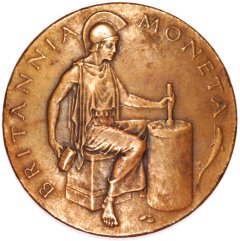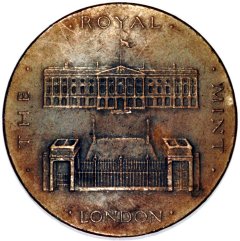| The Very Highest Quality Coins... |
| The Royal Mint |
|

|
|
|

|
|
|
The Romans
The Romans set up the first London mint about the end of the 3rd century A.D. but it functioned for no more than about
40 years. Minting was resumed in London soon after 650 A.D. but it was not until the reign of Alfred the Great (871 - 899) that a London mint became more firmly established and its history continuous.
Ethelred II
At that time it was one of about 30 mints and the number increased to more than 70 in the reign of Ethelred II (978 - 1016) before beginning to decline, By the middle of the 13th century minting was mainly confined to London and Canterbury and from the mid 16th century, London's monopoly was normally complete.
Where Was It?
The location of the early London mint is not clear. Certainly by about 1279 it had moved to secure quarters within the Tower of London where it remained for the next 500 years.
Tower Hill
The mechanisation of minting processes in the 17th century aggravated the already cramped conditions in the Tower and in 1811 the mint moved to a purpose built factory nearby at Tower Hill. By the 1960's, after much extension and renovation, little remained of the original mint building.
Llantrisant
Rebuilding was proposed, and it was the task of producing many millions of coins in readiness for decimalisation in 1971, while at the same time not neglecting overseas customers, which finally prompted the decision in 1967 to build a new mint at Llantrisant in South Wales.
Mintmarks
Throughout most of this period, the Royal Mint, has been one of the few mints in the world which does not normally use a mintmark, at least for British coins. Most other mints have employed a mint letter or other mark.
In 1983 a mintmark was introduced on the new one pound coin issued for the first time in that year.
Llantrisant Mint Mark on the 1983 One Pound Coin
On the milled edge of the coin is the Llantrisant mint mark - a cross crosslet. This is the first United Kingdom coin to be struck with this distinctive feature. The shape of the cross alluding to Llantrisant, which translated from the Welsh means "Church or Parish of the Three Saints".
Visiting The Royal Mint
The Royal Mint maintain a small "Coin Shop" at Llantrisant, which is open to the public.
Obviously, this only sells Royal Mint products, not competing products such as Krugerrands.
It is not now possible for the public to have conducted tours round the Mint. These used to be available at the old Tower Hill premises, indeed I had the pleasure of a tour, as a member of the public, in about 1965.
When the new mint opened at Llantrisant, for a number of years, public tours were available. These were stopped about 10 years ago for various reasons, security, and Health & Safety regulations.
The Royal Mint is an efficient, modern busy factory, but like most factories it contains some danger. I was fortunate enough to have a conducted tour around it on Friday, 10th March, 2000. I was able to see far more than on the previous "public" tour, but can well understand that such tours could easily interfere with production. There are numerous fork lift trucks transporting tons of metal in various forms, loading them into overhead hoppers, and moving them between processes. Although the factory appears well-designed, and much of the machinery features safety protection barriers, it would clearly be undesirable on safety grounds, to have large numbers of visitors on the premises.
Which Llantrisant?
I would advise that it is not worthwhile making a diversion or special journey to visit the Royal Mint's shop, but possibly worth a brief visit if you happen to be in the area.
What is worth noting, though, is there are at least two places named Llantrisant, and they are close enough to confuse visitors, being about 40 miles apart in the same part of South Wales. One is a small village north-east of Newport, the Llantrisant which contains the Royal Mint is to the West of Cardiff.
About The Royal Mint, according to The Royal Mint..
The Royal Mint is one of the world's leading mints, producing the coins of the United Kingdom and those of more than 60 countries around the world. Yet the thoroughly modern Mint of today has its roots in the ninth century, for the tradition of minting in Britain, the history of The Royal Mint and the story of Britain itself are woven together through time. As Britain has evolved through war and political change, social and economic progress and advances in science and technology so has the coinage, always reflecting a Britain of its time and marking the nation's most important occasions across the centuries.
Through the story of Britain's coins history unfolds, from Roman occupation to an imperial heyday, from Anglo-Saxon silver pennies to the mighty gold Sovereign of Henry Tudor or from the coins of a youthful Queen Elizabeth II to those of an experienced monarch who has reigned beyond a Diamond Jubilee. A coin represents so much more than a unit of currency or a token of exchange. Each coin, struck in one year, captures a moment in time.
The coinage of the UK has undergone dramatic changes during the Queen's reign.
History of The Royal Mint
From silver pennies to commemorative crowns
1000
By the end of the first millennium and the reign of Aethelred 'The Unready' (978-1016), silver pennies had been struck and used in England for over 300 years.
1066
After the Norman Conquest the coinage became so reliable that it attracted to itself the name 'sterling'.
1279
The mint in London had become dominant and the moneyers were operating in the Tower of London.
1662
Screw presses and horse-driven rolling mills were installed and the ancient method of striking coins by hand was finally abandoned the following year.
1810
The Royal Mint began production at new custom-built premises on Tower Hill.
1815
Campaign medals were struck for the victorious troops at Waterloo, the first time there had been such work.
1899
Production rose to 100 million coins a year.
1953
First coins of Her Majesty the Queen were issued.
1968
Her Majesty the Queen officially opened the new Royal Mint on 17 December.
2000
The Royal Mint welcomed the new millennium with a splendid £5 coin.
2013
The Royal Mint celebrates 60 years of the Queen's coinage.
2014
Coins commemorating Queen Anne, the outbreak of the First World War, Trinity House and the Commonwealth Games are released.
You may wish to visit some of our other pages:
Complaint about Royal Mint Prices
RoyalMint.Co.Uk Domain Name
British Coin Denominations. What's a Groat,? etc.
Common Names of British Coins. What's a Tanner?
Inscriptions on British Coins
Value of my Coin. What's it Worth?
Olympic Coin Design Competition
The Royal Mint has announced a public design competition, to create 29 designs for 50 pence coins, for the 30th Olympics Games London 2012.
We guess that the new coin designs will start appearing on coins dated 2009, and will continue through 2010, and 2011, to 2012 itself.
This holds the possibility that the British public will catch coin fever in a similar way to the US States Quarters programme, which ran over 10 years with 5 coins per year making a total of 50 designs.
The London Mint Office
Be careful not to mistake the confusingly named London Mint Office for the Royal Mint, or the old London Branch of the Royal Mint.
| ...at the Lowest Possible Price |
|
32 - 36 Harrowside, Blackpool, Lancashire, FY4 1RJ, England. Telephone (44) - (0) 1253 - 343081 ; Fax 408058; E-mail: The URL for our main page is: https://24carat.co.uk | Chard(1964) Ltd |